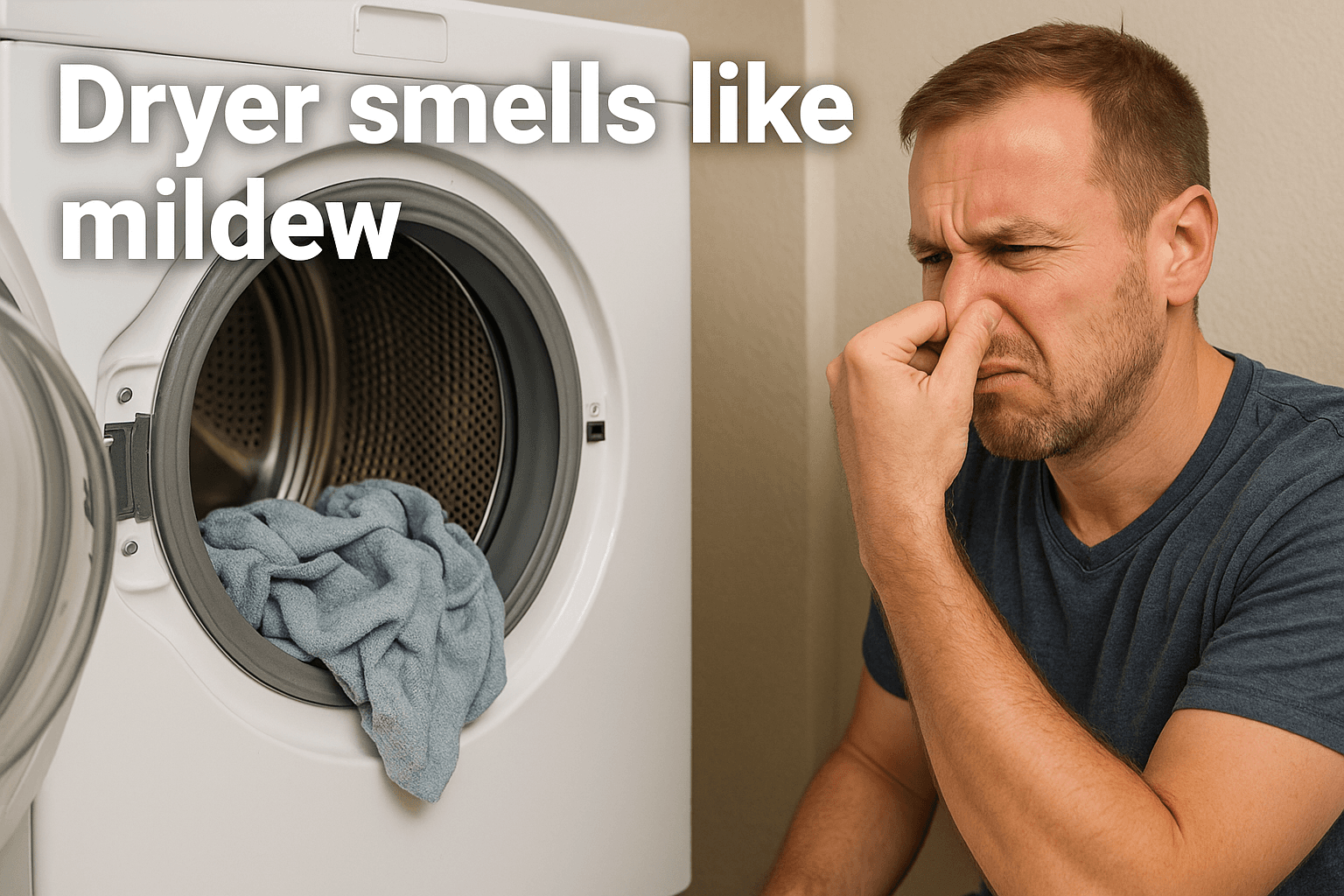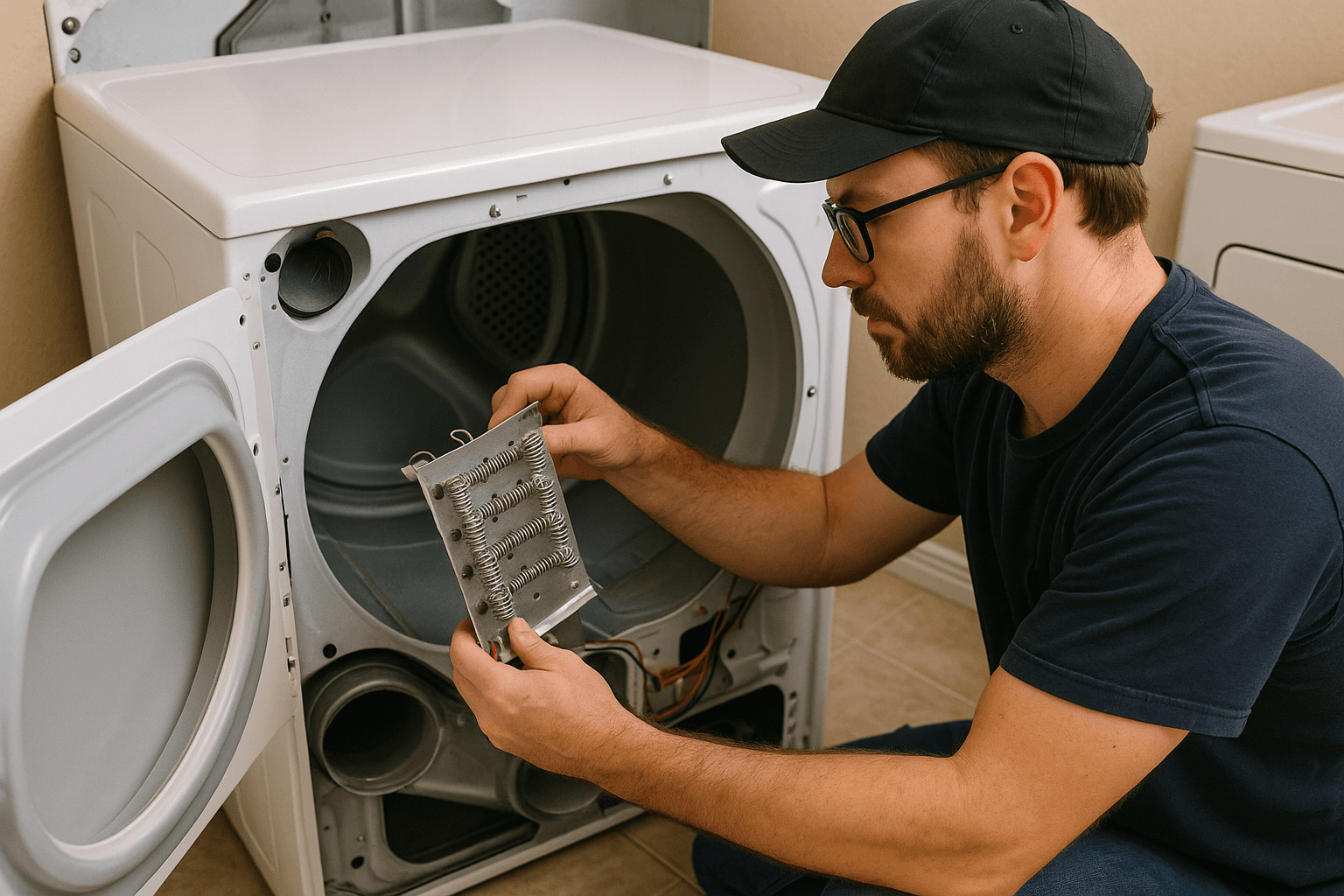Repair help
Dryer Spins but No Heat? Here's What to Check First
AZparts Team
Updated on July 3, 2025
8 min read
A dryer spins but no heat can be frustrating, and it’s a more common issue than you might think. From blown thermal fuses to faulty thermostats, several components could be the culprit behind your dryer’s heating failure. In this guide, AZParts will help you identify the most likely causes, walk you through step-by-step fixes, and share simple tips to prevent heating issues from returning.

1. Common Causes When Dryer Spins but Has No Heat
Before attempting any repairs, it’s essential to understand why your dryer spins but has no heat. Several internal components can fail or become damaged over time, leading to heating issues. Here are the most common causes to check first:
1.1. Tripped Thermal Fuse
A tripped thermal fuse is one of the most common reasons a dryer spins but does not heat. This small safety device cuts power to the heating element when the dryer overheats. When it blows, the drum keeps spinning, but no heat is produced.
Most thermal fuses are single-use and located near the exhaust vent. Although replacement is usually simple, it’s important to find and fix the cause of overheating. Ignoring it can lead to repeated failures and safety risks.
Thermal fuse cuts power to the heating element when the dryer overheats (Source: AZParts)
1.2. Faulty Heating Element
In electric dryers, the heating element is responsible for warming the air that dries your clothes. If this component becomes damaged or breaks, the dryer may continue to spin but will no longer produce heat.
In gas dryers, a similar issue can occur if the burner system fails. A broken heating element or burner disrupts the drying process and needs to be inspected and replaced to restore proper function.
1.3. Defective High-Limit Thermostat
The high-limit thermostat is a safety device that monitors the temperature inside your dryer. If the dryer overheats, this thermostat shuts off the heating element to prevent damage or fire. However, when the thermostat itself becomes faulty, it may cut power to the heat even during normal operation.
A defective high-limit thermostat can cause the dryer to spin without producing heat. Replacing it may solve the problem, but it is also important to check for airflow blockages or other overheating causes that could have triggered the issue.
1.4. Malfunctioning Timer or Control Board
The timer and control board work together to manage each stage of the drying cycle, including when to activate heat. If either component malfunctions, the dryer may continue to spin but fail to signal the heating system to turn on.
These issues can be difficult to diagnose without experience, as they often involve complex electrical connections. Professional diagnosis is usually recommended in this case.
Malfunctioning control board causes dryer not to heat (Source: Freepik)
1.5. Broken Temperature Switch or Cycling Thermostat
The temperature switch and cycling thermostat help regulate consistent heat inside your dryer. If either part becomes faulty, it may not control temperature properly, leading to overheating or no heat at all.
In many cases, excessive heat caused by these components can trip the thermal fuse and shut off the heating system entirely. Both parts can be tested with a multimeter to check for proper function.
1.6. Power Supply Issues (Electric vs. Gas)
If your dryer spins but does not heat, the problem may lie with its power source. Electric dryers require two separate voltage lines to operate both the motor and the heating element. If one line is faulty, the drum may spin while the heat remains off. In gas dryers, the machine may run but fail to heat if the gas supply is turned off or blocked.
Power-related issues are potentially hazardous, especially when dealing with high-voltage electricity or flammable gas. If you suspect a power problem, it is safest to contact a professional technician for inspection and repair.
Problem with power source leads to dryer to spin but not to heat (Source: Pinterest)
2. How to Fix a Dryer with No Heat
Once you’ve identified the possible causes, the next step is to troubleshoot them one by one. Follow these simple steps to check key components and restore heat to your dryer:
2.1. Step 1: Check Power Supply
Begin by checking whether your dryer is receiving enough power. Electric dryers require two separate power lines. One supplies electricity to the drum, while the other powers the heating element. If one line fails, the dryer will spin but not produce heat.
For gas dryers, make sure the gas valve is open and the gas is flowing properly. Always unplug the dryer or turn off the circuit breaker before inspecting any electrical connections.
2.2. Step 2: Clean the Lint Filter and Exhaust Vent
A clogged lint filter or exhaust vent can block airflow and cause the dryer to overheat. Start by removing any lint from the filter and vacuuming the filter housing. Then disconnect the vent hose and check for any buildup inside. Use a vacuum or brush to remove debris, and inspect the duct leading outside to make sure air can flow freely.
This simple maintenance step helps your dryer run more efficiently, lowers fire risk, and extends its lifespan. If the dryer filter or dryer vent hose is damaged or too old to clean properly, you can find a replacement at AZParts to restore safe and effective operation.
Clogged lint filter causes the dryer to overheat (Source: Pinterest)
2.3. Step 3: Test the Thermal Fuse
To find out if a blown thermal fuse is causing the dryer to lose heat, start by unplugging the dryer for safety. Locate the fuse, usually positioned near the exhaust vent. Use a multimeter to test it by placing the probes on both ends of the fuse. If the multimeter shows no continuity, the fuse is no longer working and needs to be replaced.
A tripped fuse often points to overheating, so make sure to check for airflow issues before installing a new one. If you need a replacement, AZParts offers high-quality dryer thermal fuses that fit many dryer models and help restore safe, reliable performance.
AZParts offers high-quality dryer thermal fuses that fit many dryer models (Source: AZParts)
2.4. Step 4: Inspect the Heating Element
If your dryer is still spinning but not heating, the heating element could be the problem. This part generates the heat needed to dry clothes and is typically located behind the back panel. Always unplug the dryer before opening any panels.
Use a multimeter to test the heating element for continuity. If there is no reading, the element is faulty and should be replaced. AZParts offers a range of high-quality dryer heating elements that fit many dryer models.
Testing dryer heating element with a multimeter for continuity (Source: AZParts)
2.5. Step 5: Evaluate Thermostats and Timer
If the heating element is working, check the cycling thermostat, high-limit thermostat, and timer. These components help regulate temperature and control the heating cycle. A faulty thermostat may shut off heat too early or prevent it from turning on at all. The timer can also fail to send the proper signal to activate the heating system.
Use a multimeter to test the thermostats for continuity. If any of them are defective, replacing them may solve the problem. You can find reliable dryer thermostat replacements at AZParts to help restore proper temperature control and safe operation.
AZParts dryer thermostat parts help restore proper temperature (Source: AZParts)
3. Final Tips to Prevent Dryer Heating Issues
While fixing heating problems is important, preventing them in the first place can save you time, money, and stress. Here are a few simple maintenance tips to keep your dryer running efficiently and reduce the risk of future heating issues:
3.1. Clean the Filter After Every Use
After each drying cycle, lint collects in the filter and can block hot air from flowing properly. If not cleaned regularly, this can cause the dryer to overheat and lose efficiency. Cleaning the lint filter every time you use the dryer helps it run smoothly, dry clothes faster, and prevent heat-related problems.
Cleaning the lint filter every time you use the dryer helps it run smoothly (Source: Pinterest)
3.2. Regularly Clean the Drain Hose
Over time, lint, debris, or moisture buildup can clog the drain hose and reduce airflow in your dryer. This can make it harder for the machine to dry clothes properly and may lead to overheating. Checking and cleaning the drain hose regularly helps maintain airflow, improves drying performance, and reduces the risk of future heating issues.
3.3. Avoid Overloading the Dryer
Putting too many clothes in the dryer at once can block airflow and make it harder for heat to circulate. This not only slows down drying time but also increases the risk of overheating. To keep your dryer working efficiently, load it only up to the recommended capacity.
Avoiding dryer overload reduces the risk of overheating (Source: Freepik)
3.4. Check the Power Source Regularly
If your dryer isn’t getting enough power, it may run but not produce heat. Loose plugs, tripped breakers, or weak connections can affect performance. Checking the power source regularly helps ensure the dryer gets the electricity it needs to operate safely and effectively.
Fixing a dryer that spins but has no heat is easier when you understand the common causes and follow the right steps. Regular maintenance and timely part replacement can help your appliance run safely and efficiently. If the issue continues, it is a good idea to check other components such as the dryer gas converter, dryer element coil, or dryer coil valve.
AZParts provides a wide range of high quality dryer replacement parts compatible with many trusted brands including Admiral dryer parts, Amana dryer parts, and Estate dryer parts, giving you everything you need to restore your dryer's performance with confidence.
Contact Information:
- Address: 8 The Green, Ste A, Dover, Delaware 19901-3618, United States
- Email: support@azparts.com
Dryer
Further Reading
Further Reading





